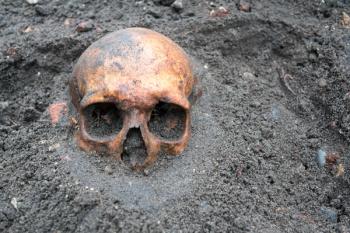
Forensic Applications of Isotope Ratio Mass Spectrometry
The isotopic profile of a material refers to the ratios of the stable isotopes of elements contained within, such as 2H/1H, 13C/12C, and 18O/16O. Biological, chemical, and physical processes cause variations in the ratios of stable isotopes; analysis of a material for its distinctive isotopic signature can thus be used to reveal information about its history. Isotope ratio mass spectrometry (IRMS) is a technique used to measure the relative abundance of isotopes in materials. Forensic investigators have used IRMS to measure a variety of materials, such as drugs, explosives, food, and human remains. In a recent web seminar, Lesley Chesson, the president of IsoForensics, Inc., explained how IRMS works and discussed the use of IRMS in forensic science, illustrating her discussion with several case examples.
The isotopic profile of a material refers to the ratios of the stable isotopes of elements contained within, such as 2H/1H, 13C/12C, and 18O/16O. Biological, chemical, and physical processes cause variations in the ratios of stable isotopes; analysis of a material for its distinctive isotopic signature can thus be used to reveal information about its history. Isotope ratio mass spectrometry (IRMS) is a technique used to measure the relative abundance of isotopes in materials. Forensic investigators have used IRMS to measure a variety of materials, such as drugs, explosives, food, and human remains. In a recent web seminar, Lesley Chesson, the president of IsoForensics, Inc., explained how IRMS works and discussed the use of IRMS in forensic science, illustrating her discussion with several case examples.
Below, Chesson answers questions raised during the seminar and other common questions about the technique.
The Methods
You explained that isotope abundances are measured as ratios and reported in “delta” notation, comparing the isotope ratio of the sample to the isotope ratio of a standard. Is the comparison to a standard done to compensate for mass abundance differences from one mass spectrometer to another?
This question can be answered in three parts:
IRMS instruments contain sensitive electronics that are subject to environmental and inherent variability. Though a good isotopic standard always has the same isotopic abundances, different mass spectrometers and even the same mass spectrometer on a different day may produce results that differ significantly. Reference gases are used to ensure a repeatable measurement can be made independently of factors like sample heterogeneity or sample introduction. Laboratory standards are used to ensure biases are corrected. It is very important to distinguish standards used for daily measurement from standards used for δ-notation.
“Delta” notation is just notation-a way to report isotope ratios in a way that is convenient for interpretation. It is possible to translate a δ-value to an “absolute ratio,” independent of the isotope ratio scale. However, those numbers usually end up being very small for many of the isotope systems of interest, and understanding the significance of differences between measurements can be difficult. For example, 2H/1H ratios for tap water range from 0.000134 to 0.000153, whereas 18O/16O ratios for the same water samples range from 0.001959 to 0.002018. It can be difficult to compare your sample of interest to a “typical” sample on the “absolute” scale. With δ-notation, negative δ2HVSMOW values always represent samples with less 2H than Vienna standard mean ocean water (VSMOW); negative δ18OVSMOW values always represent samples with less 18O than VSMOW. “Delta” notation provides a convenient “zero” point for comparisons.
“Delta” notation also has a built-in shorthand that shows that the measurement was made using standards that are traceable to a community standard. If absolute ratios were used instead, it would be unclear without extensive description how the measurement could be comparable to other measurements. This is especially important for isotope ratio analysis, as the technique tends to be much more repeatable (within a particular laboratory, with a particular instrument, over a short period of time) than it is reproducible (between laboratories and instruments, over long periods of time).
Why do we need to use a magnetic sector mass spectrometer to measure isotope ratios? Why couldn’t we use a quadrupole MS instrument? After all, I can get isotope concentrations using quadrupole MS. And would any other type of high-resolution mass spectrometer work?
Isotope ratio mass spectrometers have multiple collectors that can detect the presence of multiple isotopes simultaneously. Other types of mass spectrometers-like quadrupole MS instruments-have a single collector. These instruments are not precise enough to distinguish isotope ratios that are important to ecologists, geologists, and forensic scientists at natural abundance levels. I will note that the relatively new technique of isotope ratio infrared spectroscopy (IRIS) is also capable of measuring isotope ratios at a similar precision.
You mentioned that CO2 molecules can contain three different isotopes, resulting in molecular masses of 44, 45, and 46, respectively. What is the probability that a CO2 molecule with mass 46 is composed of 12C17O17O instead of 12C16O18O?
Extremely low. Molecules of CO2 composed of 12C17O17O occur at a concentration of 0.142 ppm, about 28,000 times more rare than 12C18O16O (which occurs at a concentration of 4000 ppm, or 0.40%). In comparison, molecules of CO2 composed of 12C16O16O (mass 44) have a relative abundance of 98.40%; CO2 molecules with mass 45 composed of 13C16O16O and 12C17O16O have relative abundances of 1.11% and 748 ppm, respectively.
When analyzing the isotope ratios of CO2, how are the contributions of the two species of mass 45 split up? For example, can you tell if the contribution is from 13C or 17O?
An IRMS instrument cannot separate the presence of 17O in mass 45 from 13C in mass 45. So, a calculation is necessary-a 17O “correction.” This correction is based on relative abundances of 18O to 17O. There are multiple published studies on the relationship of 18O to 17O in various materials, and therefore there are multiple options available in an IRMS instrument’s software for applying the 17O correction to measured data. One commonly used relationship was published by Santrock and colleagues (1).
Is it essential to calibrate the reference gas in continuous-flow IRMS?
No. The laboratory standards included in the analytical sequence-which have been previously calibrated-allow the analyst to normalize measurement results to the appropriate isotope scale. However, calibrating the reference gas is easy, and setting a rough estimate for a particular gas tank allows you to monitor in real time the measurement results for laboratory standards and samples.
If we use two-point calibration to calibrate an IRMS instrument, do we still need a calibrated reference gas?
No. See the answer above.
Do the Faraday collector cups in a continuous-flow IRMS system need to be cleaned? Or just replaced? And how frequently?
No, Faraday cups in an isotope ratio mass spectrometer do not need to be cleaned. I’ve personally never heard of one needing replacement. More commonly, the electronics and amplifiers may need replacement due to age.
One part of an IRMS system does need regular cleaning and replacement: the ion source. Filaments usually last 9–12 months before burning out. During replacement, it’s a good idea to check the other source parts (lenses, plates, shields, and so on) for residues that should be removed. The flight tube on most mass spectrometers can also be “baked out,” though the need for this is uncommon.
Is the isotopic analysis of sulfur used in forensic applications?
Yes. Sulfur (S) isotope analysis has been used to characterize-or “fingerprint”-manufactured materials like gunpowder. In biological materials, such as keratin (hair, feathers) or ivory, S isotopes have been used to reconstruct an animal’s diet or potential origin, or both. Sulfur isotope variations in organic materials are ultimately related to the weathering of local bedrock and contributions of 34S-enriched sulfur from marine sources to the terrestrial landscape. For instance, the sulfur isotopic composition of sheep wool can vary depending on how far the flock grazes from the coast.
Are there any other elements used to investigate forensic cases?
Yes. While I discussed mainly the isotopes of the bio-elements hydrogen (H), carbon (C), nitrogen, (N), and oxygen (O) in the presentation, sulfur (S), chlorine (Cl), strontium (Sr), and lead (Pb) isotopes have also been used in forensic applications.
You mentioned that in addition to IRMS, two other techniques can be used to measure isotope ratios: multicollector inductively coupled plasma–mass spectrometry (MC-ICP-MS) and IRIS. Can you tell us a more about IRIS? How does it work? What are the advantages or disadvantages compared to IRMS?
IRIS instruments measure the absorption of light by simple gases, such as carbon dioxide, methane, or water vapor. Gas molecules have distinctive rotational-vibrational energies when different isotopes are present; the resulting spectra can be used to infer the abundance of various isotopes in the gas sample. IRIS instruments are generally much smaller than IRMS instruments, fitting on benchtops or even in car trunks. They are typically cheaper than IRMS instruments and cost less to operate day to day. The training required to operate an IRIS instrument is also less than that required to operate an IRMS instrument. However, when IRIS instruments are not measuring pure gases, interfering molecules such as ethanol in water can cause biases. IRMS instruments are much less sensitive to these kinds of errors, because of the sample preparation peripherals used to produce a pure gas for measurement.
About how much does an isotope ratio mass spectrometer cost to buy? And operate?
Costs to purchase an IRMS system can range from US$250,000 to US$1 million or more, depending on the number of peripherals (such as sample introduction systems) desired. Daily operation costs include ultrahigh purity carrier and reference gases, plus sample capsules or vials and reference materials. Many IRMS instrument manufacturers offer yearly service contracts; operators benefit from regular training.
Applications
You talked about using IRMS to identify human remains and thus solve “cold cases,” through tap water isotope maps. Will that approach work if an individual drinks a lot of bottled water?
Yes. Most of the bottled water we drink is, in fact, filtered tap water. As an example, Dasani bottled water, which is produced by the Coca-Cola Company, describes its production like this: “We start with the local water supply, which is then filtered for purity using a state-of-the-art process called reverse osmosis. We then add a special blend of minerals for that pure, crisp, fresh taste.” So, by drinking Dasani bottled water, you are actually drinking local tap water.
There are some bottled waters that come from sources far distant to your location-for example, Evian or FIJI. However, even if you drink these bottled waters regularly, you probably don’t make tea or coffee with them, or cook with them. The majority of your water intake is likely local tap water.
Are the results of IRMS readily accepted as standards of evidence in criminal cases?
Yes and no. The results of IRMS-or any other isotope measurement technique-are not presented in court as frequently as the results of DNA analysis, and this means that isotope data are not as readily understood (and accepted) as DNA evidence. In the U.S. legal system, I am aware of a single example of isotope data presented in court, in City of Pomona v. SQM North America Corp. (2). Outside the United States, isotope data have been used in a few additional legal settings, including the London 21/7 bombing (3); the Floyd Landis doping case (3); the investigation of “antique” ivory from Five Star Auctions and Appraisal in Toronto, Canada (5); and a case involving pesticide-adulterated milk powder in New Zealand (6).
Are isotopes being used to screen foods and authenticate different products?
Yes. Stable isotope analysis has been used for decades to test foods for product authentication and verification. For example, carbon isotopes can be used to detect the illegal addition of corn (maize) or cane sugar to honey. The first studies describing this application were published in the 1970s. More recently, protein isolated from honey has been measured for its carbon isotopic composition and compared to measurements made on the “bulk” honey. The isotopic difference between the protein and the “bulk” material allows for detection of adulteration of honey with not only C4-derived sugar, but also C3 sugar, such as beet or rice. The Association of Official Analytical Chemists (AOAC) published this technique as Method 998.12.
Between 2005 and 2009, the European Union funded a large, multi-country project to develop traceability systems for food. Called TRACE (Tracing Food Commodities in Europe), the project included isotope analysis. Dozens of papers have been published on the results of that project, including measurements made on wine, oils, meats, and cheeses.
References
(1) J. Santrock, S.A. Studley, and J.M. Hayes, Anal. Chem. 57, 1444–1448 (1985).
(2) SQM North America Corporation v. City of Pomona, SCOTUSblog (2014). http://www.scotusblog.com/case-files/cases/sqm-north-america-corporation-v-city-of-pomona-2/
(3) “London 21/7 Bomber Appeals Over 'Unsound' Evidence of Expert Witness,” The Guardian, 25 March 2014. http://www.theguardian.com/law/2014/mar/25/london-bomber-appeal-claims-unsound-evidence-crown-witness
(4) J. Macur, “New Finding Challenges Tour Champ’s Claim,” The New York Times, 1 August 2006. http://www.nytimes.com/2006/08/01/sports/othersports/01landis.html
(5) E. Chung, “Illegal Elephant Tusk Vendor Convicted with Help of Radiocarbon Dating,” CBC News, 3 March 2015.
(6) “Otago Forensic Chemistry Expertise Used in 1080 Milk Powder Case,” University of Otago Bulletin Board, 15 April 2016. http://www.otago.ac.nz/otagobulletin/news/otago609313.html
Newsletter
Get essential updates on the latest spectroscopy technologies, regulatory standards, and best practices—subscribe today to Spectroscopy.





